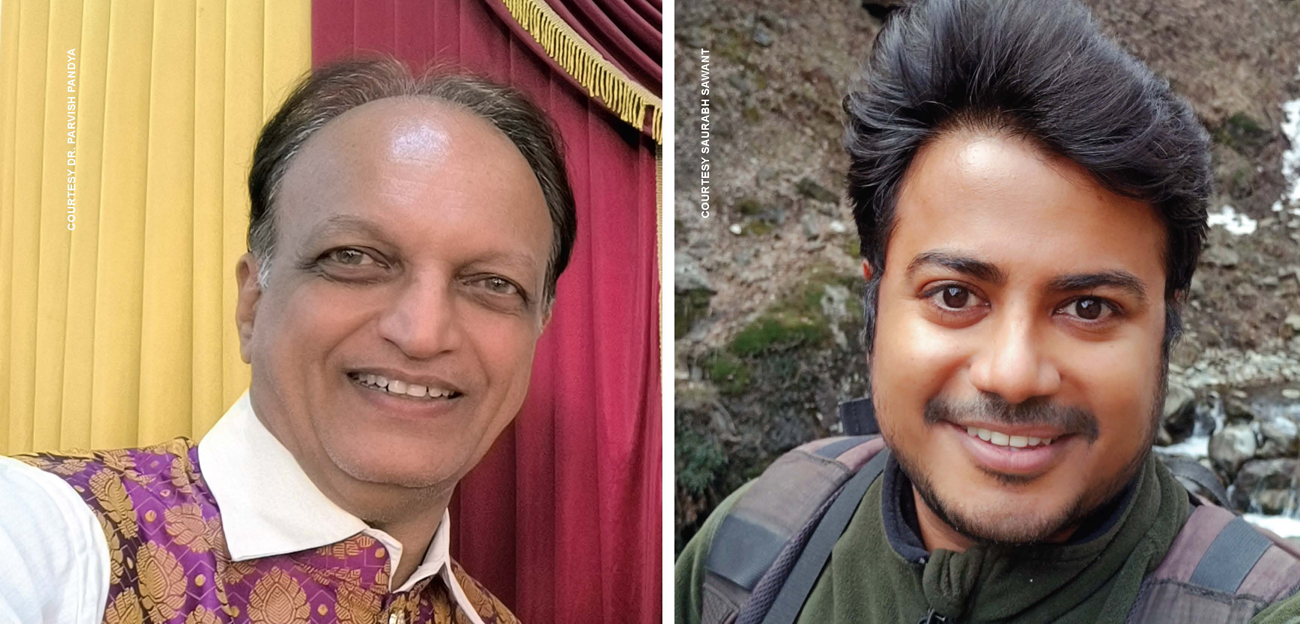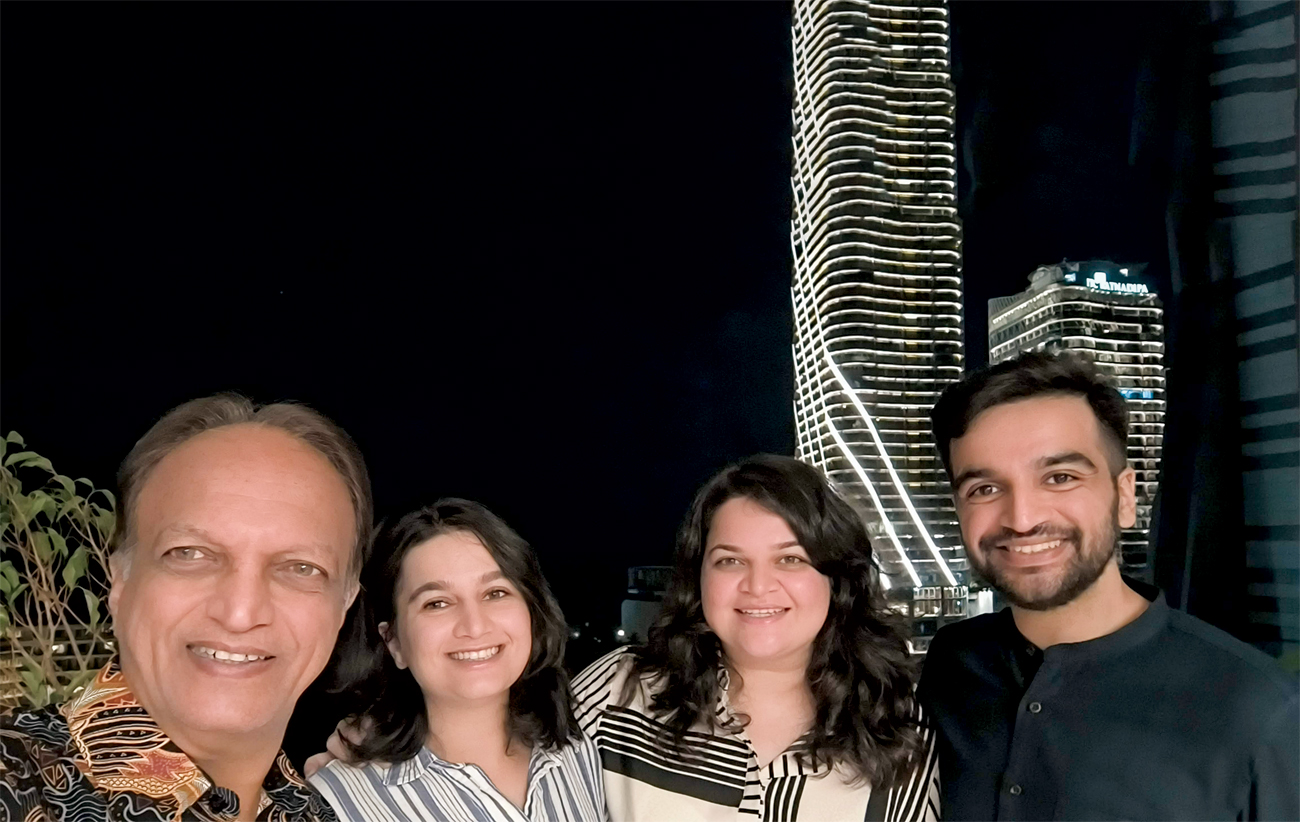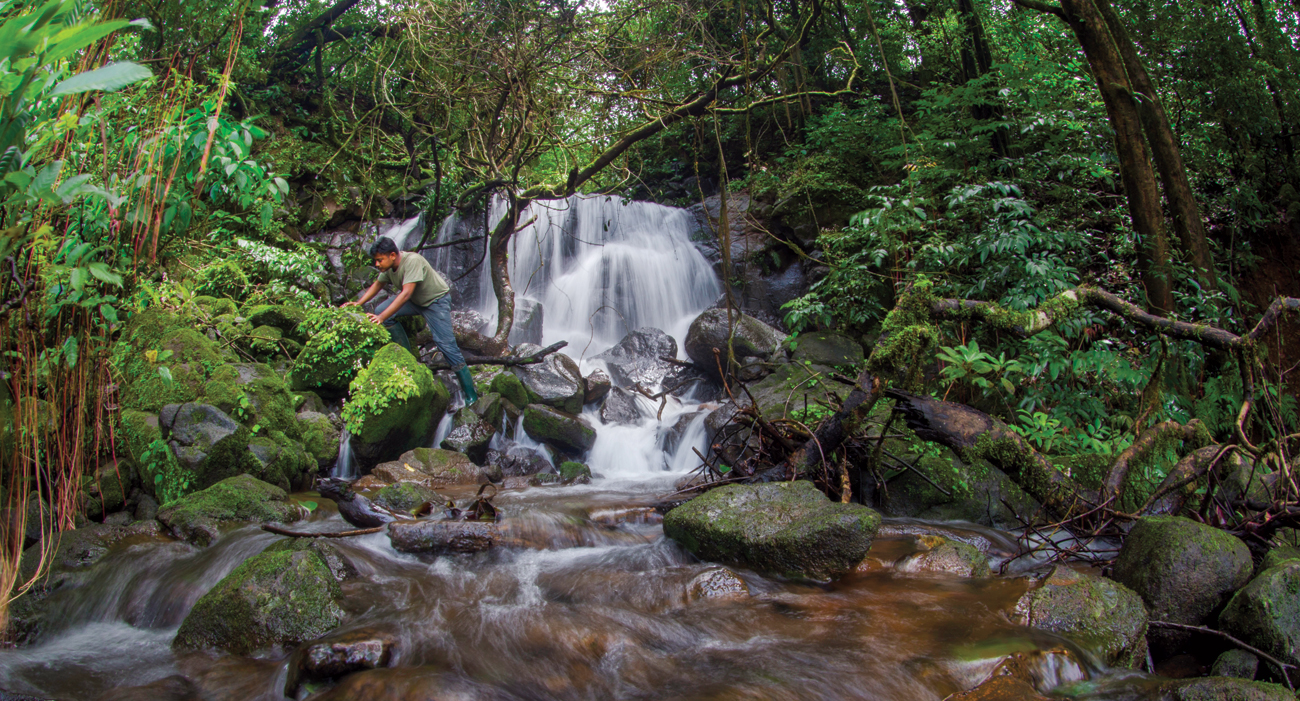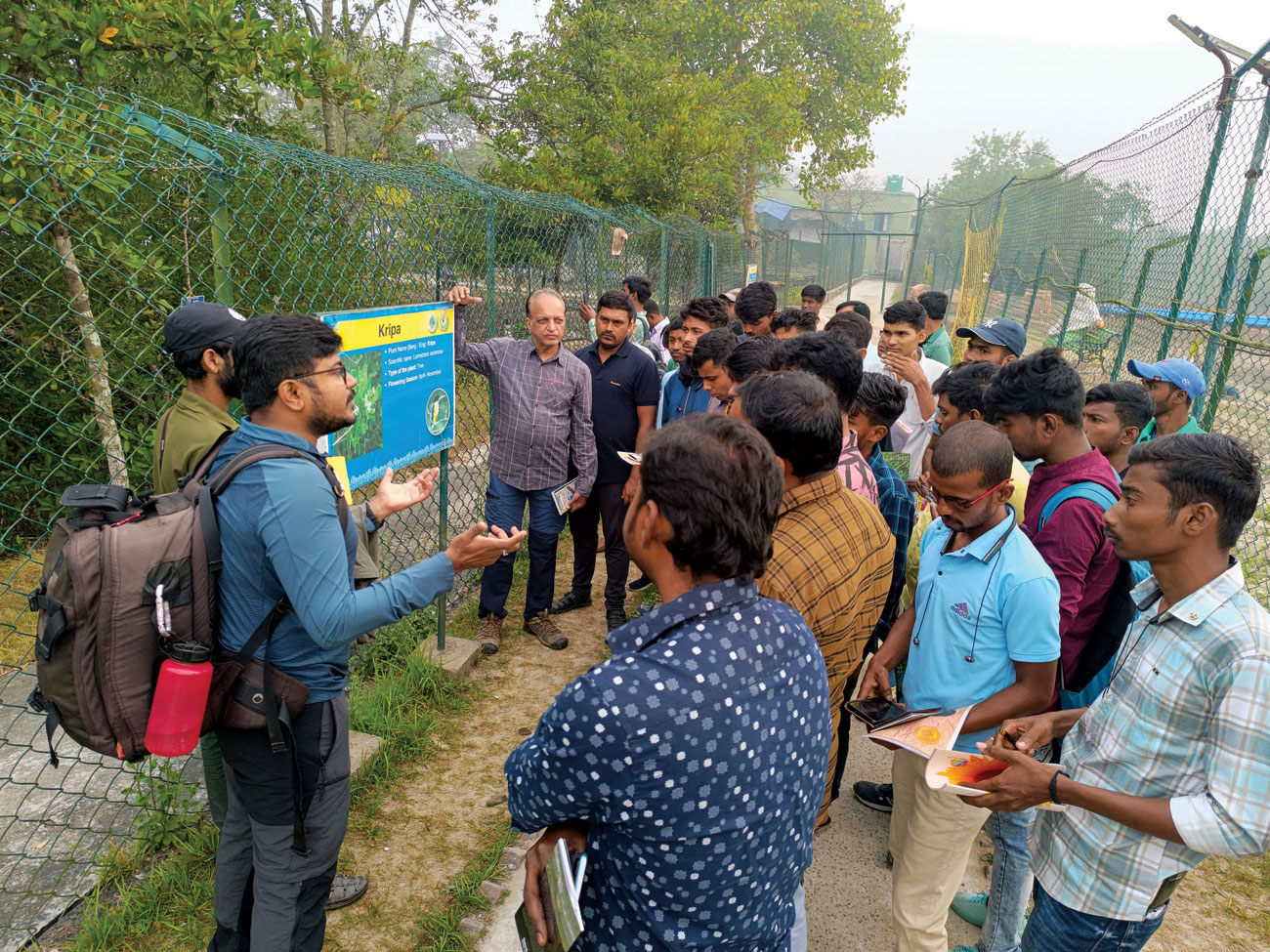The Sanctuary Interview: Meet Dr. Parvish Pandya And Saurabh Sawant
First published in Sanctuary Asia,
Vol. 45
No. 6,
June 2025
Ask one of the thousand zoologists he has mentored over the decades and they will tell you: “Dr. Parvish Pandya, is a legend!” A wildlife biologist, educator, and conservationist with more than 40 years of experience, he is passionate about nature education, biodiversity, climate change, and empowering youth and local communities through environmental awareness and action. Saurabh Sawant is one of India’s finest ornithologists and is a conservation photographer of great repute. A naturalist, nature educator, researcher, and storyteller, his work bridges science and the wild, with deep expertise in birds, amphibians, and odonates. His photographs and films have graced national and international platforms, while his fieldwork has taken him across India from mangroves to mountains collaborating with Forest Departments, scientists, and communities alike. Our teammates at Sanctuary, they’re among the many who have kept the fire burning.
Tell us a bit about your growing years? Where did you go to school, and what got you wrapped up with the wild world that is your life?
PP: I’m a Bombay boy! I grew up in the suburb of Sion in Mumbai, and was schooled at Our Lady of Good Counsel High School. Two years later, I found myself at S.I.E.S.(The South Indian Education Society) College, after which I went on to R. Ruia College, where I completed my B.Sc., M.Sc. and Ph.D. at the ripe old age of 32 years! The Sanjay Gandhi National Park (SGNP) and The Bombay Natural History Society (BNHS) were my gateways to nature. Given the slightest chance you can find me exploring SGNP. It is home.
SS: I was born, raised, and educated in Mumbai’s suburbs. Back then, the city still carried the scent of the wild. In the suburbs, I’d cycle into the mangroves, catch crabs and fish, and spend hours watching mudskippers and cormorants. You could still see real soil by the roadside, and grass alive with grass yellow butterflies and magnificent dragonflies. There were snakes and mysterious tree frogs in the still-unpaved apartment complexes. I remember one frog vividly, though I can no longer identify it. That memory feels like a species lost to time. But my true immersion into the wild came through my ancestral village, Tulas in Vengurla, Sindhudurg, a little Konkan gem by the sea. Every year, it was like a pilgrimage for me. Hills, rivers, fields, and sea were all within reach, and I’d explore it all, barefoot and free. That’s where nature truly claimed me.

Dr. Parvish Pandya (left) is an accomplished educator, and conservationist with over 40 years of experience. Saurabh Sawant (right) is one of India’s leading ornithologists and a highly respected conservation photographer. Photo Courtesy: Dr. Parvish Pandya and Saurabh Sawant.
Who shone the light for you? Who nudged you in the direction your life took?
PP: There are too many people to list. Dr. Sálim Ali, Humayun Abdulali, J.C. Daniel of BNHS. My college professors Prof. Prabhu at S.I.E.S., Prof. M.G. Dhavale and Dr. S.V. Shanbhag, who instilled an interest in zoology, particularly in ecology, organic evolution and taxonomy in me. But honestly, it was the forest itself – its silence, its rawness – that became my truest teacher. My parents, especially my mother, had great trust and confidence in me. I was a rank holder throughout my school and college years. My mother would say, “Go where your heart takes you, and do what your conscience tells you is right.” She supported my nature rambles; and though she knew that in those days there was hardly any pecuniary gain, she knew I was earning the good will of people and nature.
SS: Without hesitation, my parents. They regularly took me to Vengurla and never flinched at the sight of bruised knees or muddy elbows. They took me across the subcontinent, nurturing a love for the land. My mother inspired curiosity. My father handed me my first binoculars and a film camera. Through their cultural and family-oriented travels, they taught me to notice birds, dragonflies, butterflies, rivers, and mountains, and most importantly to find joy in small, meaningful details. They shaped me more than I could ever admit. They taught me how to travel not just across geographies, but through wonder. They taught me to love the world.
What keeps you ticking TODAY... and if you were not doing what you do now, where might life have taken you?
PP: Though I retired from Bhavan’s College, Andheri after serving there for 37 years, the joy of watching young minds awaken to the beauty of nature keeps me going. I have been involved in preparing an army of nature warriors. My work gives me satisfaction and reassurance, that the next generation will prove to be better stewards of the biosphere than our generation. I was equally tugged in the direction of becoming a medical practitioner, or a singer! I’m still infused with a love for the careers I didn’t follow… only the melody has changed.
SS: No matter what I’d be doing professionally, I know I’d still be wandering the Earth watching birds. It’s not a hobby – it’s a way of being. For me, nature is where the divine reveals itself. Birding, exploring, photographing frogs, tracking mammals; it all still excites me like it did the first time. There’s still wonder in every corner. How can one lifetime ever be enough to witness all the natural miracles on this planet?

Dr. Pandya with his daughters and son. He believes that nature has the power to inspire our children, teaching them that cooperation and kindness are not just virtues, but essential strategies for survival. Photo Courtesy: Dr. Parvish Pandya.
What’s your take on the state of wildlife conservation in India today?
PP: There’s greater awareness and a stronger demand for policy frameworks that take into account the imperative of protecting the biosphere. However, fragmented implementation and rapid ‘development’ threaten our ecological stability. You need to look at the way the climate is shapeshifting. It’s a mixed bag – hopeful, but precariously balanced.
SS: Despite the challenges, I believe India is doing well, especially when compared globally. But ‘good’ isn’t good enough. We can and must do better. Much of the world has lost its biodiversity chasing a development model that we’re still aspiring to. Those definitions must evolve. India has vast forests, free-flowing rivers, and rich biodiversity. This is our natural capital – the bedrock of our economy. India has been a leader in species conservation. The next leap must be landscape-level restoration and resilience. With climate change accelerating, the focus must shift to large, connected ecosystems. Promoting privately protected reserves and community-led conservancies could be the way forward.
And across the world?
PP: We’re seeing passion and an urgency in the young population to change our collision course with nature, but they are not in charge yet and it’s a race against time. Political will and corporate accountability lag far behind science, ethics and common sense.
SS: Most nations are scrambling to protect remnants of what we in India still have. The clock is ticking. Globally, the priority must be to embed biodiversity into every economic decision across sectors, borders, and budgets. We need a new model, one where ecological health is not just an obligation, but a national security and economic stability issue. There are cascading risks if we continue to undervalue biodiversity. We can’t afford that.
You are both leaders in your fields. Do you actually believe the next generation of nature conservationists/field biologists is up to the tough task ahead?
PP: Absolutely. I’ve seen brilliance, dedication, and resilience in young conservationists. They need guidance and the support of their elders, but they carry fire in their bellies – and their hearts are in the right place. Yes, they are up to the task because they know they must partner with nature to repair the damage their elders have caused.
SS: It’s a steep climb. Even today, conservationists and field biologists are too few, and often scattered. Working in silos won’t win battles that are this complex. The real challenge is to balance essential development with ecological sustainability. Taking extreme positions won’t help. Instead, we must turn the straw man into a steel man – understanding the best version of the other side’s argument and responding with empathy and intelligence. “The greatest victory is that which requires no battle.” We need to speak the language of policymakers, industries, and communities while gently teaching them ours.

Saurabh Sawant in his element – herping in a stream in the Western Ghats. Whether it’s birding, exploring, photographing frogs, or tracking mammals, each adventure excites him just the same. Photo Courtesy: Saurabh Sawant.
Practically speaking, what are our choices? What, for instance, is the solution/direction needed to survive the conjoined biodiversity and climate crises ahead of humanity?
PP: We need to rethink growth itself – shift from extraction to regeneration. Indigenous wisdom, local stewardship, and honest governance must be our North Stars. Above all, we must act collectively, not in a selfish and destructively competitive manner.
SS: Technology, when applied ethically and intelligently, is our greatest ally. Only tech can scale the solutions fast enough while giving nature the time it needs to regenerate. We need urgent investment in green and nature-based technologies from precision agriculture to remote sensing for conservation, to clean energy transitions. Even nuclear energy, if made demonstrably safer and more accountable, should be considered alongside other clean sources. But let’s be clear: tech alone won’t save us. We need economic systems that embed biodiversity and ecosystem services into financial decision-making. Short-term profits must give way to long-term resilience. Without that shift, we’ll always be playing catch-up.
You both believe that diversity is key to life on Earth, but clearly the conservation movement in India badly needs the unification you speak of... bridges between the silos that divide us. Is this even possible? Do we have the time?
PP: Yes, and yes! We are primates, and primates work in collaborative groups. It’s not an option, it’s a survival imperative. The generation about to take charge will see the wisdom in collaboration across sectors – science, policy, society. It’s our only way forward. We will possibly be forced to ditch egos, share credit, and work like a species that is part of the larger ecosystem, not in grand isolation.
SS: It must and it can. But only through open, inclusive dialogue. We can’t expect people in remote areas to choose forests over roads unless they have access to education, health, and livelihood security. And we can’t expect industry to act if we don’t show them the long-term value of sustainability. Conservationists of the future must become facilitators. Our real work will be to understand the root issues, connect diverse players such as communities, scientists, industries and governments, and guide the system toward balance. We’ll need to be strategists, bridge-builders, and quiet puppeteers.

In March 2024, Dr. Parvish Pandya and Saurabh Sawant conducted a Nature Guide Training Programme at the Sundarban Tiger Reserve in West Bengal. The participants, all members of the Joint Forest Management Committees (JFMC), were later appointed as nature guides by the Forest Department. Photo Courtesy: Dr. Parvish Pandya.
War clouds seem to be spreading across our planet like a mange. Any hope that humanity might see the light and unite to fight the ultimate war... a climate breakdown?
PP: There’s always hope. Crisis often awakens conscience. As the climate clock ticks louder, I believe unity will come – not by choice, but by necessity.
SS: Wars worsen under ecological stress. Drought, displacement, and food insecurity will escalate conflict if we don’t address the root cause. Yet, humanity tends to respond late. I’m not naively optimistic but I am hopeful. I believe we will cross a threshold where the need to act will become too loud to ignore. And when that moment comes, I trust in our collective intelligence to respond. Until then, conservationists must keep the conversation alive, adapt the message, and refine strategies. Because when the reckoning comes, we’ll be the ones who kept the fire burning.
Any seeds of hope for our children?
PP: We must have faith in our children. The Earth needs their curiosity, wonder, and strength. Nature will work its magic and demonstrate how cooperation and kindness are not charitable acts, but survival strategies. They need us to set a good example. I believe they will grow up to protect what they love, and love what they protect. Since nature is self-healing, we can be sure the planet will once again be bountiful and beautiful.
SS: To err is human but to learn from those errors is divine. Accept the world as it is, but never give up on making it better. Whatever your path, carry nature with you. Be curious. Be strong. Be kind. Be solution-oriented. It’s not as bad as it seems and even if it is, it can still be mended with wisdom, compassion, and courage.





